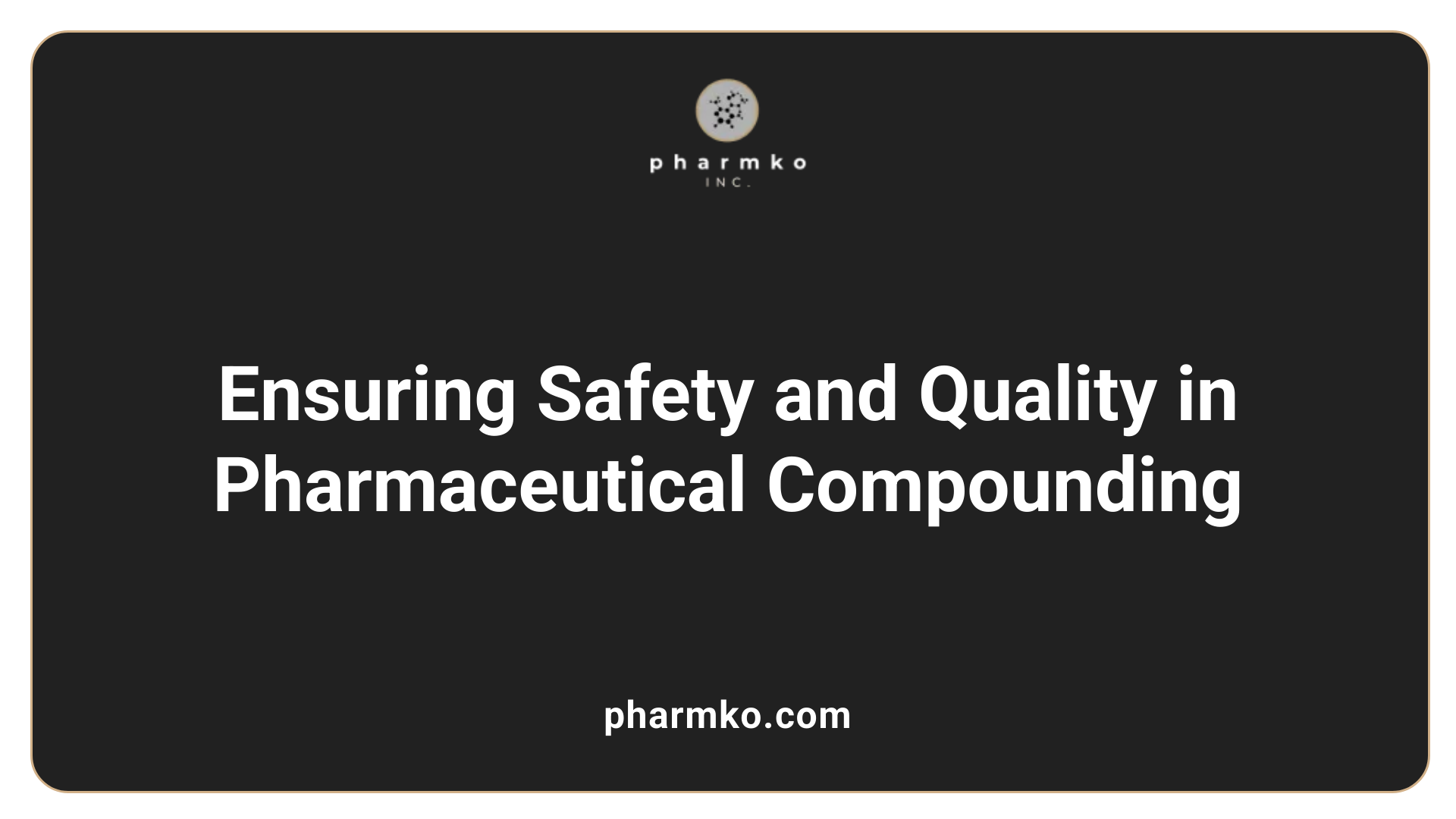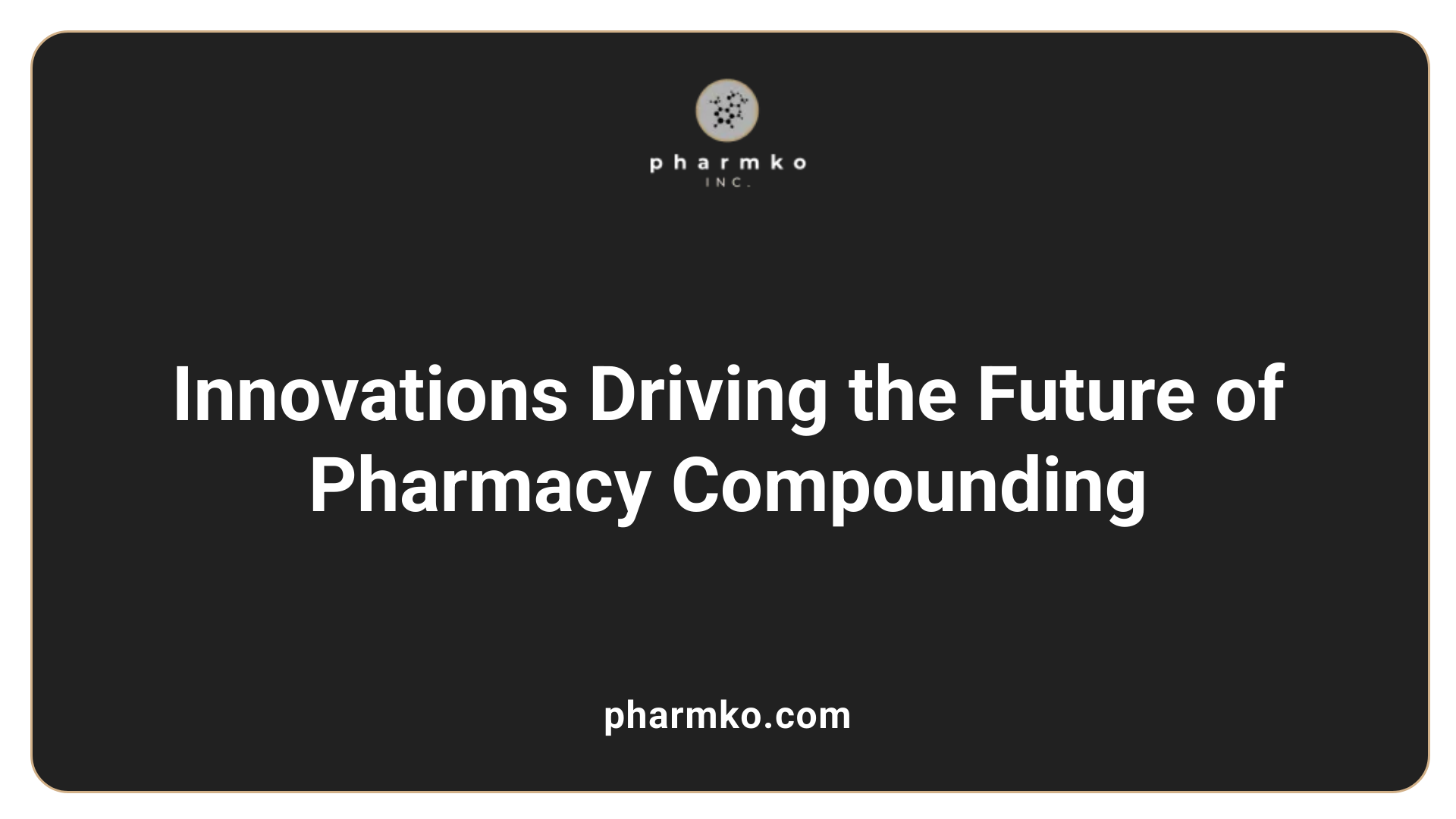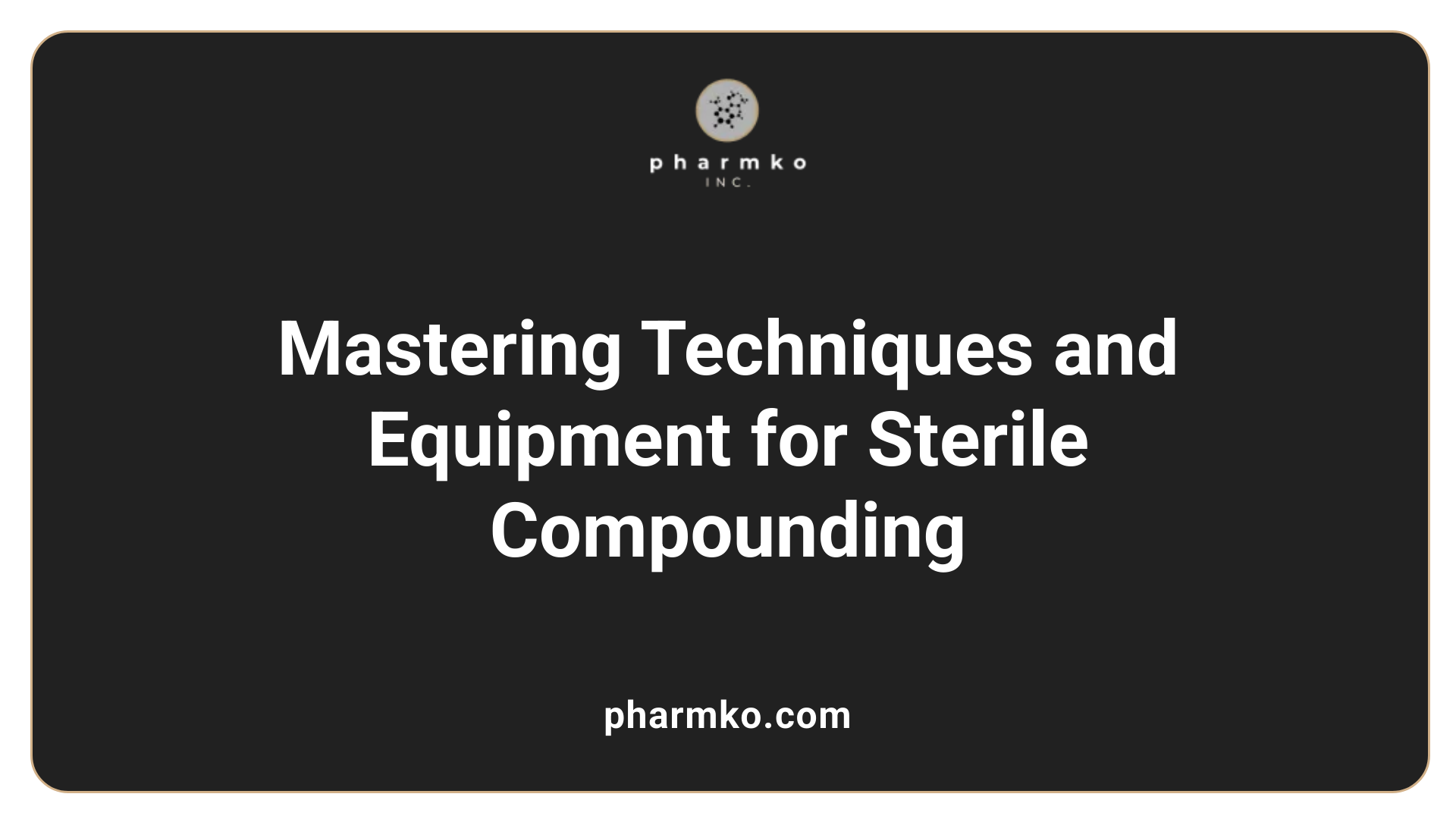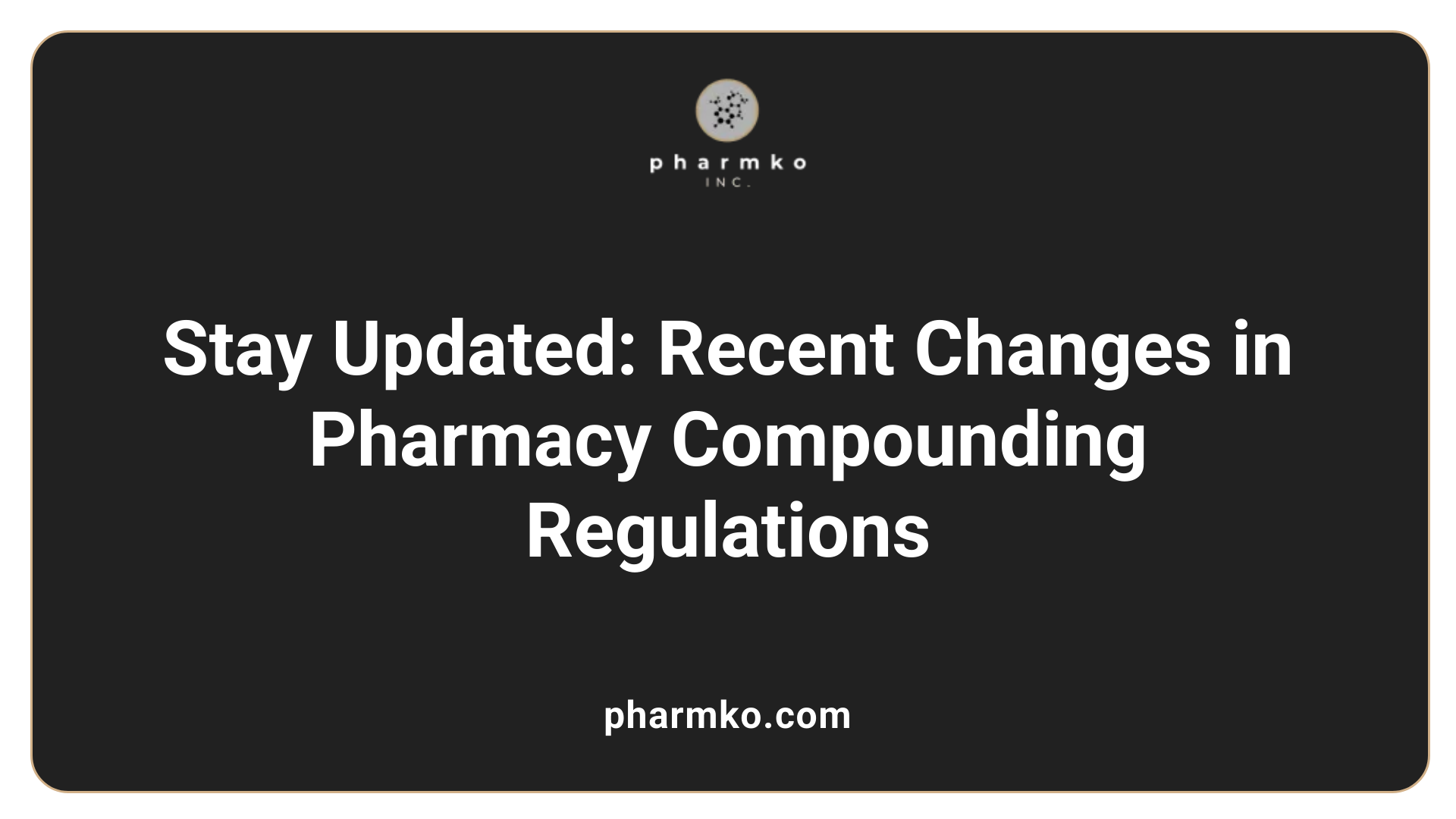What are the latest compounding techniques?
Introduction to Modern Drug Compounding Techniques
Pharmaceutical compounding lies at the heart of personalized medicine, catering to unique patient needs that standard FDA-approved drugs may not fulfill. As technological advances and regulatory updates transform practices, understanding the latest compounding techniques is essential for healthcare providers committed to safety, efficacy, and quality. This article explores current practices, cutting-edge innovations, regulatory frameworks, and future trends shaping the evolving landscape of pharmacy compounding.
Current Practices and Standards in Pharmaceutical Compounding

What are the current practices and standards in pharmaceutical compounding?
Contemporary pharmaceutical compounding follows rigorous guidelines designed to maximize patient safety and medication quality. The United States Pharmacopeia (USP) provides essential standards through chapters <795> for nonsterile preparations, <797> for sterile preparations, and <800> for hazardous drugs.
These standards emphasize proper formulation procedures, environmental controls, personnel training, and quality assurance. Compliance ensures compounded medications meet safety and efficacy requirements, reducing risks like contamination or incorrect dosing.
Regulatory oversight is further reinforced by federal laws such as the Drug Quality and Security Act (DQSA). DQSA distinguishes between traditional compounding pharmacies (503A) and outsourcing facilities (503B). The latter are subject to FDA inspections and must adhere to current good manufacturing practices (CGMP), which are more stringent.
While compounded drugs are not approved by the FDA and do not undergo pre-market review, following USP standards helps maintain high quality standards. Many state boards of pharmacy endorse or mandate adherence to these guidelines as part of their licensing and inspection processes.
Recent updates to USP <797>, which took effect November 2023, incorporate technological advances and risk management strategies. These include requirements for staff training, environmental monitoring, proper facility design, and safe handling of hazardous drugs.
Overall, the practice of pharmaceutical compounding is increasingly standardized, emphasizing detailed procedures, system validations, and safety protocols. This evolution aims to protect patient health while accommodating personalized medication needs and emerging technologies.
The following table summarizes important regulatory frameworks and standards:
| Regulation/Guideline | Focus Area | Compliance Requirement | Impact on Practice |
|---|---|---|---|
| USP <795> | Nonsterile compounding | Formulation procedures, documentation | Ensures consistency and safety in nonsterile preparations |
| USP <797> | Sterile compounding | Environmental controls, personnel training, quality checks | Prevents contamination, supports sterile environment |
| USP <800> | Hazardous drugs | Handling procedures, safety protocols | Protects staff and environmental safety |
| DQSA (FDA law) | Facility regulation | Inspections, CGMP compliance for 503B | Higher standards for outsourcing facilities |
This integrated approach fosters safer practices, advances technological integration, and aligns compounding with modern pharmaceutical standards.
Recent Advancements Accelerating the Field

What are recent advancements and innovations in pharmacy compounding techniques?
Recent progress in pharmacy compounding is largely fueled by the adoption of cutting-edge technologies. Automation tools now assist compounding professionals by streamlining documentation, ensuring compliance with data reporting standards, and reducing human error. These systems help maintain precise records of compounded medications, enhancing safety and accountability.
Innovative drug delivery methods are also emerging, such as transdermal gels, sublingual tablets, and flavored suspensions. These forms improve patient adherence by making medications easier and more pleasant to take, especially for populations like children and the elderly.
Tailoring medications to individual patients is becoming increasingly common. Pharmacists utilize precise compounding techniques that consider genetic information and metabolic differences. This move toward personalized medicine aims to optimize therapeutic effects while minimizing side effects.
Additionally, advanced digital tools such as artificial intelligence (AI), augmented reality (AR), and virtual reality (VR) are transforming pharmacy practices. These technologies support remote education, clinical decision-making, and medication management, making innovative care more accessible.
Wearable sensors are another leap forward, providing real-time monitoring of health parameters and medication adherence, which enables proactive adjustments to therapy.
Despite these exciting developments, challenges remain. Ensuring data security, complying with evolving regulations, and training personnel to proficiently use new systems are ongoing hurdles to fully realizing the benefits of technological advancements in compounding.
Procedures, Equipment, and Regulatory Guidelines for Sterile Compounding

What are the procedures, equipment, and regulatory guidelines for sterile compounding?
Sterile compounding demands a controlled environment specifically designed to maintain high standards of safety and sterility. The facilities include physical features such as ISO Class 5 environments created by Primary Engineering Controls (PECs) like laminar airflow workbenches, biological safety cabinets, and isolators. These controls rely heavily on HEPA filtration to keep airborne particles at a minimum.
The procedures for sterile compounding are detailed in Standard Operating Procedures (SOPs). These include equipment sterilization, thorough cleaning of the environment, environmental monitoring, and personnel practices. Personnel must follow strict garbing routines—wearing gowns, gloves, masks, and hair covers—and practice aseptic techniques meticulously. Regular competency assessments ensure staff maintain proper technique.
Equipment used in sterile compounding ranges from sterilizers to environmental monitors, and increasingly sophisticated automated compounding devices and barrier systems. All equipment must be calibrated and validated routinely to ensure accuracy and effectiveness. Proper documentation and validation protocols are essential components of these practices.
Regulatory oversight primarily adheres to standards set by USP chapters <797> and <800>. These standards emphasize environmental controls, personnel training, quality assurance, and appropriate beyond-use dating of compounded sterile preparations. Additionally, FDA and state pharmacy boards provide oversight, ensuring facilities follow proper procedures.
Environmental monitoring involves continuous checks of air quality, surface cleanliness, and bacterial contamination levels. Validation involves regular testing of sterilization efficacy, validation of airflow in PECs, and calibration of measurement tools. Strict cleaning routines, gowning procedures, and sterilization protocols help prevent contamination.
In summary, robust procedures, advanced equipment, and strict adherence to regulatory guidelines are vital for safe, effective, and compliant sterile compounding, protecting patient health and minimizing risks of contamination.
Best Practices and Quality Assurance in Compounding Pharmacy
What are the best practices and quality assurance measures in compounding pharmacy?
Ensuring the safety and efficacy of compounded medications requires meticulous attention to best practices and robust quality assurance protocols. In pharmacy compounding, adherence to established standards such as USP <797> is fundamental. This includes maintaining controlled environmental conditions, utilizing proper aseptic techniques, and carefully documenting every step of the compounding process.
Environmental controls are critical to prevent contamination. This involves working in cleanroom facilities with ISO Class 7 buffer and ante areas, equipped with HEPA filters and properly maintained air systems. Personnel must follow strict gowning procedures, including masks, gloves, gowns, and hair covers, to minimize microbial introduction.
Staff training and competency assessments are essential components. All personnel involved in sterile compounding should undergo regular training on aseptic technique, hand hygiene, environmental cleaning, and equipment use. Continuous education ensures staff stay updated with current protocols and technological advancements.
Quality testing and documentation serve as the backbone of quality assurance. Routine environmental monitoring includes air and surface sampling to detect microbial or particulate contamination. Certification of primary engineering controls, like laminar airflow hoods, ensures they operate within specified standards. All processes—from master formulation and batch records to final product labeling—must be thoroughly documented. This traceability supports legal compliance and facilitates investigation of any adverse events.
Facility design plays a pivotal role. Properly configured spaces with designated clean areas, handwashing stations, and controlled airflow help maintain sterility. Regular maintenance of HVAC systems, chemical sterilizers, and sterilization equipment further supports operational integrity.
In sum, a combination of strict environmental controls, ongoing staff training, rigorous quality testing, and carefully designed facilities form the foundation of best practices in compounding pharmacy. Applying these ensures compounded medications meet the highest safety and quality standards, protecting patients and fostering trust in pharmacy services.
Industry Standards and Regulatory Updates

What are the current industry standards and updates related to pharmacy compounding?
Recent advances in pharmacy compounding are reflected in the updated USP chapters <795> for nonsterile preparations, <797> for sterile preparations, and <800> for hazardous drugs. All three chapters became official as of November 1, 2023, marking a significant milestone in setting uniform standards for compounding practices.
These revisions were the result of thorough stakeholder engagement, including input from healthcare professionals, regulatory agencies, and industry experts. The changes emphasize a risk-based approach, requiring compounding personnel to carefully assess the level of risk associated with different preparations.
Key elements of these updates include enhanced safety protocols, comprehensive personnel training, strict environmental controls, and rigorous quality assurance measures. They prioritize patient safety by updating procedural standards, environmental requirements, and validation processes for equipment.
Regulatory agencies, especially the National Association of Boards of Pharmacy (NABP), have aligned their inspection protocols and accreditation processes to these new standards. This alignment ensures that pharmacies and outsourcing facilities maintain compliance, reducing the risk of contamination and errors.
In addition to USP standards, industry guidance from organizations like the International Society for Pharmaceutical Engineering (ISPE) offers supplementary resources. These technical documents focus on quality systems, facility design, and regulatory compliance, supporting pharmacies in implementing advanced technology, such as automated compounding devices and proper environmental monitoring.
Overall, these updates aim to modernize pharmacy compounding practices, ensuring safe, effective, and high-quality medications tailored to individual patient needs. The continuous evolution of these standards reflects ongoing efforts to adapt to scientific advancements and emerging safety challenges.
Scientific and Technical Foundations of Modern Drug Compounding
What are the technical and scientific considerations in modern drug compounding?
Modern drug compounding requires a detailed understanding of both the scientific principles and technical procedures involved in creating personalized medications. One primary consideration is formulation stability. Ensuring that active ingredients remain effective over time and under various storage conditions is essential. Stability depends on factors such as ingredient purity, proper mixing techniques, and environmental controls.
Compatibility of ingredients is another vital aspect. Some drugs or excipients may react with each other, which could compromise safety or efficacy. Compatibility testing helps prevent adverse chemical interactions and ensures the final product maintains its intended therapeutic effect.
Bioavailability, or how well a medication is absorbed and utilized in the body, is critical, especially for customized formulations. Adjustments in formulation, such as particle size reduction through grinding or using specific vehicles, can enhance bioavailability, making medications more effective.
Understanding pharmacokinetics—the movement of drugs within the body—and pharmacodynamics—the drug's effects—guides compounding decisions. These scientific insights influence dose accuracy, release profiles, and the selection of excipients to optimize therapeutic outcomes.
Regulatory adherence plays a pivotal role in safeguarding patient health. Facilities engaged in compounding are categorized as pharmacies or outsourcing facilities, each subject to different regulatory standards, including Good Manufacturing Practices (GMP) and current good manufacturing practices (CGMP). US regulations require strict protocols to prevent contamination and incorrect dosing.
Technological advancements like 3D printing, computer-aided design, and automation systems have revolutionized compounded pharmacy practices. These tools enhance precision, reduce human errors, and allow for the production of complex, individualized medications.
Ensuring safety and quality remains central to compounding. This involves rigorous training of personnel, strict adherence to aseptic techniques, environmental and equipment controls, and comprehensive quality assurance measures. Chemical analysis, sterility testing, and stability studies are conducted regularly to verify that compounded drugs meet safety standards.
In summary, modern drug compounding is a meticulous process that combines scientific expertise with advanced technology. The goal is to create safe, effective, and personalized medications that meet each patient’s unique needs while complying with evolving regulatory frameworks.
Safety Protocols, Risk Categories, and Future Directions
What are the safety protocols and risk categories in sterile compounding?
Safety in sterile compounding relies on meticulous aseptic precautions to prevent microbial contamination and ensure medication safety. This includes strict hand hygiene, appropriate gowning, cleaning surfaces thoroughly, and using sterilized supplies.
Facility design is vital, with controlled airflow—often using laminar airflow hoods or cleanroom environments—and environmental monitoring to detect airborne or surface microbes. Personnel must be trained on aseptic techniques and demonstrate competency regularly.
The United States Pharmacopeia (USP) <797> classifies compounded sterile preparations (CSPs) into different risk categories:
| Category | Description | Key Characteristics |
|---|---|---|
| Category 1 | Low risk | Prepared in ISO 5 PEC in unclassified or segregated spaces, with BUDs up to 12 hours at room temperature or 24 hours refrigerated |
| Category 2 | Medium risk | Prepared in ISO 5 environments like cleanroom suites, allowing BUDs up to 45 days if sterile ingredients are used |
| Category 3 | High risk | Involves non-sterile starting materials or higher complexity, with BUDs up to 90 days at room temperature |
Each risk category requires specific safety protocols, including environmental controls and storage conditions, tailored to the level of contamination risk.
Personnel are responsible for applying aseptic techniques, including proper gowning, hand hygiene, and the use of personal protective equipment (PPE). SOPs are crucial for ensuring consistent practices.
Environmental monitoring through air and surface sampling helps detect microbial presence early, preventing contamination of compounded medications.
Overall, these protocols and risk classifications work together to minimize contamination, protect patient safety, and maintain the integrity of sterile preparations.
What are future trends in automation and safety?
Emerging technologies such as robotic compounding, automated IV workflow systems, and advanced filtration methods are revolutionizing sterile compounding. Robots can precisely measure, mix, and dispense medications, reducing human error and contamination risks.
Automated systems are often integrated with electronic health records (EHRs) and barcode or RFID technologies to verify ingredients, document procedures, and track beyond-use dates, enhancing safety and traceability.
Real-time monitoring of environmental parameters like temperature, humidity, and airborne particulates allows proactive management of the compounding environment. Continuous oversight ensures compliance with USP <797> standards.
Closed System Transfer Devices (CSTDs) provide airtight environments during medication transfer, reducing exposure to hazardous drugs and contamination.
These advancements aim to improve consistency, efficiency, and safety in compounded medication production, particularly in high-demand settings like hospitals and clinics.
How is systematic quality management shaping the future?
Quality management in sterile compounding involves rigorous validation, staff training, and adherence to established standards such as USP <797>. Regular audits, batch testing, and sterility checks are essential components.
Implementation of comprehensive SOPs, personnel competency assessments, and ongoing education programs ensure continuous improvement and safety.
Modern software solutions like Assure-Trak support compliance by integrating workflow management, documentation, and error prevention features.
Additionally, there is an increased focus on aligning practices with national and international standards, fostering a culture of safety. These systems help identify safety gaps, monitor equipment performance, and support corrective actions.
By adopting these systematic approaches, pharmacies and healthcare providers can reduce errors, enhance medication safety, and ensure high-quality compounded products for patients.
Looking Ahead: Innovations Shaping the Future of Pharmacy Compounding
As pharmacy compounding continues to evolve, embracing technological innovations, rigorous safety standards, and regulatory compliance will be vital. Advances like automation, robotics, and real-time monitoring promise to enhance precision and safety, while ongoing education and adherence to updated guidelines ensure practitioners can meet modern healthcare demands. The future of pharmaceutical compounding lies in collaborative, science-driven approaches that prioritize patient-centered care, safety, and efficacy. By integrating cutting-edge techniques with robust quality assurance systems, the field will continue to advance, ensuring compounded medications remain a safe and effective cornerstone of personalized medicine.
References
- Compounding and the FDA: Questions and Answers
- Updated ISMP Guidelines for Sterile Compounding and Sterile ...
- Understanding the Basics of Pharmaceutical Compounding
- [PDF] ASHP Guidelines on Compounding Sterile Preparations
- Pharmacy Compounding Solutions: Tackling Sterile Medication ...
- Sterile Compounding Resource Center |Best Practices and methods
- [PDF] 2022 ISMP Guidelines for Sterile Compounding and the Safe Use of ...
- Compounding Overview: Primary Considerations for the Workplace
- USP General Chapter 797
- Aseptic Compounding Technique: Quality and Efficiency in ...













